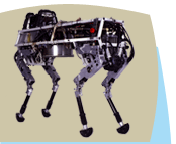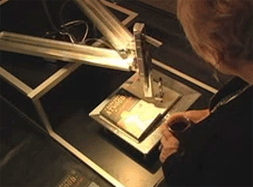

University of Memphis law professor June Entman recently took a step that deeply freaked out her first-year law students: She banned laptops in her class. As the Memphis Commercial Appeal — there’s a newspaper called “The Commercial Appeal”?? — reports:
“My main concern was they were focusing on trying to transcribe every word that was I saying, rather than thinking and analyzing,” Entman said. “The computers interfere with making eye contact. You’ve got this picket fence between you and the students.”
Entman’s students have had three classes without laptops. Cory Winsett, a first-year law student, said his participation in class has dropped because he’s too busy writing notes on the lecture. And his notes are less organized and hard to read when he gets home. “If we continue without laptops, I’m out of here. I’m gone; I won’t be able to keep up,” Winsett said.
I can understand why the students are so unsettled: One’s technology deeply affects one’s cognitive style, a topic I’ve blogged about before. Mostly, this story seems to focus on the fact that having a wifi-enabled laptop allows students to ignore the lecture — by chatting, downloading music, updating their MySpace account, whatever. While obviously that’s a concern, I’d argue that it also provides some healthy competition for the professors; too many of them read off brittle, yellowing, decades-old lecture notes and never engage their classes. They’re losing the Darwinian battle for attention for good reasons, and it’s time to cull the herd. (I’m not just flapping my gums: Whenever I speak to a college-age audience, I prep very hard to make sure I win their attention, since I know I’m going up against World of Warcraft.)
But really, it’s worth asking: How do different note-taking techniques affect your thinking? The U of M professor worries that her students are so focused on taking her words down verbatim that they aren’t listening to her. That’s a realistic concern. As a journalist, I take notes on a computer at 80-100 WPM (when I’m interviewing someone on the phone), on a notepad at probably 20-40 WPM (when I’m in the field), or simply in my memory (when I’m observing something where I’m using both my hands and can’t take notes even if I want to). I also use a tape recorder and transcriber when I need to capture every single word.
In each case I come away with a rather different experience of what I’ve seen and heard. A transcription is perfect fidelity, which can be wonderful if I have a long time to revisit the interview and muse over what someone has told me. But sometimes the full transcript almost crowds out my thinking with too much detail: I have trouble recapturing what was most interesting and electric about what my interviewee said. When I’m using a notepad, on the other hand, I tend to only record the highlights of a conversation — the stuff that hits me with particular force. So while it loses lots of detail, it can sometimes do a better job of helping me distill a interview to its true core. Typing on a computer falls somewhere in between.
As for relying on pure memory? That’s an even more interesting technology. Back in 1989, a student I knew at the University of Toronto interviewed Northrop Frye about his new book, Words With Power. The student showed up with a tape recorder but no notebook, and the tape recorder went on the fritz at the beginning of the interview. After he fussed with it for about 10 minutes, Frye gently suggested, why don’t you just forget about taking notes and just listen? So he did, and they chatted for an hour or two, and he went back and wrote down his impressions of the conversation. As I recall — ironically, I’m pulling this story from memory — there were no direct quotes in the writer’s article (because he wasn’t able to record any, of course), yet the piece did a superb job of synthesizing what Frye had said.
Some newspaper reporters back in the 40s used to go out to interview people without any note pad at all. They’d just talk to them, absorb what they heard, then go back to their desks and pound out a story. Granted, given that newspapers theoretically rely on precision and accuracy as the source for their authority, this method is pretty sketchy. But it probably produced some interesting pieces!
Here’s a crazy idea: How about having a professor assign her students into note-taking groups of three. One will listen to the lecture and take notes on a laptop; another will use a pen and notepad; a third will just sit there and listen and think. Then they pool their notes and impressions afterwards. This would never fly, of course, because if you got stuck with a couple of lousy note-takers on the day you’re assigned to sit and listen, you might get burned. But maybe not. Maybe the three of you would produce an entirely new and richer record of what had been said — and, more importantly, what you’d understood.
(Thanks to Plastic for this one!)

There’s a brilliant sex column in this week’s New York magazine that argues an interesting point: SMS text-messaging encourages New Yorkers to have more quick hook-ups, because it eases the emotional risk thereof. To quote:
It’s just the right level of intrusiveness: Your target gets the message even in a noisy bar, but unlike a phone call, it won’t wake him up from a snooze in front of The Daily Show. You can successfully express interest, but texting’s short format allows you to maintain an air of aloofness. And text rejection is much easier to get (and give) than struggling through an awkward booty phone call.
“It’s by far the best way to set up a sex date,” says Kate, a 34-year-old designer in the East Village. “No worrying if your voice sounds needy or desperate or neurotic. In texts you can be blunt, erotic, funny — all the things you want to be.”
Texting isn’t just easy — it’s sexy too. By its very nature, texting is quick and dirty, so you can get away with MY PLACE OR YOURS? and nothing else. Plus the very private can happen in public — call it exhibitionism for the shy.
New technologies, of course, are always harnessed most aggressively at first for the purpose of porn: The photograph begat nekkid 19th-century pictures, moving pictures begat more of the same, and the first corporations to launch voice-mail technology en masse were phone-dating services like Lavalife. I’d been waiting for someone to start offering porn via SMS texting, but I clearly was missing the point. The value of texting is in mediating relations between two live people — not delivering static ASCII smut.
(I should probably point out that for this posting I’ve used a photo of a mobile-phone that appears to be so ancient it predates the invention of SMS, and possibly of electricity.)
(Thanks to Emily Nussbaum for this one!)

Behold the fearsome Diablo Rojo — a seven-foot-long Giant Humboldt Squid that, as legend has it, actually attacks and eats grown men.
For years, it was assumed that the lurid stories of man-eating were simply myths. A few years ago, a National Geographic diver swam with a bunch of three-foot-long Giant Humboldt Squid, and claimed they were harmless. But Scott Cassell knows better. A longtime diver and world expert on the Squid, he recently dove into the coasts off Baja and encountered — for the first time ever — a mammoth seven-footer, which he nicknamed “Scar”. Cassell wrote a fabulous (and thoroughly terrifying) essay about the encounter on the Deeper Blue website. An excerpt:
The monstrous squid remains motionless just ten feet away. Emotions gave way to cognitive thought and I trained my camcorder on him and begin to record. Almost on cue, he begins his approach. Then, with blinding acceleration, he lurches onto me with a powerful “thud crackle”. He slams into my chest. The impact was incredibly powerful, knocking the wind out of me. His huge arms envelope my complete upper body and camera and I can feel my chest plate move as his beak grinds against it. The crackle and scratching of thousands of chitenous ring teeth against my fiberglass/kevlar chest plate is unmistakable.
Man oh man. Cassell’s prose is occasionally kind of purple, but hey — can you blame him? His description of the acoustic landscape of the squid feeding-frenzies is straight out of a Ridley Scott movie:
Thousands of ring teeth cut into the flesh of their prey so deeply, you can hear it. When they drag their victim away with pulses from their massive jet funnel, the sounds of their hapless victim being ripped apart fills the water. It sounds a bit like heavy duty Velcro being pulled apart underwater. Then the beak can be heard, that huge knife-edged beak. The gouging of bone and tissue sound like the shredding of cabbage combined with that of hacking apart coconuts with a machete.
Bow before your cephalopodic overlords, cringing humans. I give civilization maybe 15 years before the squid take over. We have no chance.
(Thanks to Chris Foley for this one!)

If you own a Roomba, there’s now MyRoomBud — a company that will sell you clothing for it. You can choose from costumes including a frog, a cow, a pig, and — ay yi yi — a little french maid.
The web site asks some funny questions …
Have you ever:
1. named your Roomba?
2. talked to your Roomba?
3. spent more time watching your Roomba than it would take you to vacuum the room(ba)?
4. bought a second Roomba so your first would not be lonely?
Number 3 strikes me as the most philosophically interesting, because a) it’s true (I’ve done it myself!), and b) it neatly exposes the point that Sherry Turkle makes about artificial life: We attribute the highest level of “realness” to robots that are slightly hapless. The fun thing about watching a Roomba clean a room is that it appears to be endearingly devoted to its task, yet also kind of stupid; it rolls over the same place several times, gets stuck in corners and puzzles over how to get out, makes cute noises.
For years, sci-fi authors have mused over our impending future in which crystallinely intelligent robots manage our lives, relieve us from drudgery, and solve humanity’s problems with their 3.5 zettahertz brains. But the reality is completely the opposite. Omnipotent machines scare the hell out of us; we get freaked out at the idea of massive corporate/government databases that “know” more about us than we do. What we prefer are machines that are designed to be imperfect, cute, and even kind of useless. We want a robot that we can dress up like a frog, a pig, or a little cow.
But you people dressing your Roombas as french maids? You need help.
(Thanks to Morgan Noel for this one!)

The stock market has long driven investors into a mild form of schizophrenia, in which they’re obsessed with uncovering the mystical patterns that supposedly underpin the chaos. UI architects develop massive displays to visualize market activity, in hopes of spying hidden rulesets; fresh-outta-college 20somethings hunch over 12-foot-square Excel spreadsheets, attempting to predict lucrative spread inflection-points.
Now a group of artists have made music out of it. Emerald Suspension is a musical unit that — as it proclaims on its web site — records music “based on patterns created by the stock market, economic indicators, algorithms, and other data sources.” Their album Playing the Market includes songs derived from the Consumer Confidence Index, the efficient market hypothesis, and measures of the national debt. As they describe one piece, “Stock Options”:
“Stock Options” is an experimental audio composition based on the Black-Scholes option pricing model and the Put-Call Parity Theorem. The composition is based on stock price, volatility, and interest rate data from 1938 to 1995, the life span of Fischer Black, co-creator of the landmark option pricing formula. The two parts of the composition represent the theoretical price changes of a call option and of a put option on the U.S. stock market over the period.
I just listened to a clip of “Stock Options” over at CDBaby, and it’s pretty cool: A creepy, building howl, rather like the sound of storm-force winds whipping through the mooring-wires for electrical towers. Very appropriate!
The only problem is that all the songs are rather atonal, a la John Cage. Possibly this is because they were trying to be faithful to the data, which likely doesn’t resolve into tuneful melodies; maybe they’re also just big fans of atonal drone music. But to me, there’s something tedious about how many wicked-cool conceptual-music projects always wind up producing unhummably shapeless background static. Why not intentionally convert the patterns into diatonic-scale music with repeatable chord patterns? Why not produce something that sounds like traditionally classical or pop music? (As an example, Blur turned the Fibonacci sequence into a hook for one of their songs.) Speaking as a longtime amateur musician with a healthy love of dissonance, there’s something kind of easy — too easy — about producing experimental electronica that winds up sounding cacophonous and entropic. But creating concept music that’s also tuneful? That’s hard.
Nonetheless, these guys certainly get an A for effort and originality.
(Thanks to Greg Sewell for this one!)

A year ago I wrote about the Eglu — “the iMac of chicken coops”, a Jetson’s-style chicken-house designed specifically to allow urbanites to raise their own flock. Today Emily Gordon alerted me the presence of the Eglu blog, in which people post about the adventures of their urban chickens — including this woman whose cats have decided that the Eglus make an excellent feline crib. The chickens aren’t so thrilled.
Given that Collision Detection is a blog, there’s probably some federal requirement that I run a certain number of cute-cat pictures each year, so this one ought to bring me up to quota.
(Thanks to Emily Gordon for this one!)

Mules are the original load-hefting technology; they’re robust, ornery, and able to traverse otherwise-impassible ground. So a company called Boston Dynamics is building a robot mule — with specs straight outta Mad Max: It’s gas-powered, moves 3.3 mph, and can carry a 120-pound load up a 35-degree slope. From their online description:
BigDog is the alpha male of the Boston Dynamics family of robots. It is a quadruped robot that walks, runs, and climbs on rough terrain and carries heavy loads. BigDog is powered by a gasoline engine that drives a hydraulic actuation system. BigDog’s legs are articulated like an animal’s, and have compliant elements that absorb shock and recycle energy from one step to the next. BigDog is the size of a large dog or small mule, measuring 1 meter long, 0.7 meters tall and 75 kg weight.
BigDog has an on-board computer that controls locomotion, servos the legs and handles a wide variety of sensors. BigDog’s control system manages the dynamics of its behavior to keep it balanced, steer, navigate, and regulate energetics as conditions vary. Sensors for locomotion include joint position, joint force, ground contact, ground load, a laser gyroscope, and a stereo vision system. Other sensors focus on the internal state of BigDog, monitoring the hydraulic pressure, oil temperature, engine temperature, rpm, battery charge and others.
Best of all is the mule’s stability: It cannot be kicked over. In this rather mind-blowing demonstration video, the scientists give the mule a powerful kick, but it doesn’t topple — it just staggers off to the side. Seriously, watch this video; the robot is so eerily lifelike that my wife implored me to “turn it off because it’s freaking me out.” I actually think its uncannyness derives less from the robot’s ambling movement than from the fact that it has no head, which makes it looks like some minor Quake demon, one of those low-level grunts that come at you in 500-phalanx packs and you just sort of blow ‘em away with a shotgun.
(Thanks to Chris Foley for this one!)

Many writers (myself included, cough cough) have recently mused on the intelligence of mobs — the peculiar smarts that emerge when thousands of people all weigh on a topic and you average their opinions. That’s why opinion “stock exchanges” like the Iowa Electronic Markets do such a superb job of predicting the outcomes of presidential elections.
But can people work collectively at physical tasks of motor control? Find out for yourself with Massively Multiplayer Pong, an online web game where you play on one of two teams, one controlling each paddle. It seems to work under a simple algorithm: Each of you drags your mouse around to try and shove the paddle up or down, and the game averages your movements. I played it for a while and my group of anonymous paddlers was surprisingly good, though it’s an unusual sensation: Because the paddle moves only mostly in the way you suggest, you feel vaguely like a toddler only partially in control of your body. It’s also really fun watching your co-players frantically joggle around as they try to predict where the ball will arrive: You become aware of your own physical “thinking through” of the calculus of the game.
What’s more, players leave and join your team as you play, which makes for some weird existential moments. When I played late one night, I started off with eight people controlling the paddle; but people gradually logged off until suddenly I was the only one left. I played alone for about two minutes, when another two people joined and I began amiably wrestling for control again. It felt like a form of proprioceptural split identity: I started out fighting with my alternate identities for control, briefly experienced a moment of unity, then divided again.
It also put me in mind of Kevin Kelly’s excellent book Out of Control, which reports a real-time example of this experiment: CGI engineer Loren Carpenter got an auditorium full of 5,000 people to control a game of Pong — each half controlling one paddle:
The audience roars in delight. Without a moment’s hesitation, 5,000 people are playing a reasonably good game of Pong. Each move of the paddle is the average of several thousand players’ intentions. The sensation is unnerving. The paddle usually does what you intend, but not always. When it doesn’t, you find yourself spending as much attention trying to anticipate the paddle as the incoming ball. One is definitely aware of another intelligence online: it’s this hollering mob.
The group mind plays Pong so well that Carpenter decides to up the ante. Without warning the ball bounces faster. The participants squeal in unison. In a second or two, the mob has adjusted to the quicker pace and is playing better than before. Carpenter speeds up the game further; the mob learns instantly.
(Thanks to Morgan Noel for this one!)

I love it: Here’s an online thingie in which you type whatever text you want into a famous picture of Einstein writing e=mc² — and it appears on the blackboard. No comment necessary, heh.
This one comes courtesy of Rachel Sklar, a blogger who formerly wrote for FishbowlNYC and has just launched her own blog Tomatoes Are Delicious — with excellent commentary on everything from media to hockey and politics. Check it out!

So, a bunch of fisherman caught this huge, 28-foot giant squid off the coast of the Falkland Island, and London’s Natural History Museum decided to put it on display. As the BBC reports, they had quite a time figuring out how to present the briny beast. It turns out it’s pretty hard to defrost a giant squid: It’s hard to time the pacing of the warm-up so the thin little tentacles don’t rot while waiting for the thick mantle to defrost.
But once the thing is de-iced, there’s an even thornier curatorial challenge: Where do you get a tank big enough — and weirdly-shaped enough — to hold a creature that is as long as a bus but thin as a human?
They called Damien Hirst, the British shock-jock artist famous for producing big icky installations of entire animals (sharks, horses) sliced like salami:
“We contacted Damien Hirst’s group after seeing their animals preserved in formalin. They put us in touch with a company who could make these tanks,” explained Mr Ablett.
The squid now resides in a glass tank, filled to the brim with preservative solution, and is one of 22 million specimens that can be seen as part of the behind-the-scenes Darwin Centre tour of the Natural History Museum.
(Thanks to Debbie Chachra and Will Hanisko for this one!)

Wow: Margaret Atwood has become the first author to sign books in remote locations — via a telepresence robot! Last fall, she hooked up with a Toronto company called Unotchit (which sounds roughly like “you no touch it”) that developed a device that works like this: Unotchit sets up its robot in a remote bookstore. Atwood logs in from home, and using a webcam, talks to people who are attending the far-off book-signing. She chats with ‘em, asks what they want inscribed on their book, and they lay it in front of the Unotchit robot. Atwood writes on a screen, and the robot replicates her pen-strokes precisely, in real-time, on the book.
The idea apparently came to her when she was totally exhausted from touring, and wondered, man, there’s gotta be a better way to do this. As the Toronto Star reports:
“The reactions have been: That’s great. She’s mad. It’s a joke. She’s ruining (book tour) signatures. I can hardly wait to have one,” she said in an interview over coffee at a downtown Toronto restaurant.
There are so many excellent layers here. First of all, this confirms my growing sense that Atwood is among the biggest secret geeks on the planet. After all, she’s basically a sci-fi author masquerading as a writer of “serious” adult nonfiction. Her “what if” novels are so superb — and so manifestly superior to her other books — that I sometimes wish she’d just give up writing about the usual maundering-around-the-kitchen-
moaning-about-your-children/divorce/boring-ass-upper-middle-class-life crap that comprises 99% of all of today’s dinosaur literary fiction, and just throw it down old-skool in sci-fi and fantasy, and crank out a bunch of 4,000-page novels with, y’know, dragons and instellar spacecraft and shit on the covers. I would so pay for that.
Secondarily, the book-signing robot neatly — and possibly even intentionally — parodies the fact that the vast majority of authors are so thoroughly wretched at book-readings, and so achingly wooden in their delivery, that they might as well send robots in their stead. (Atwood’s pretty funny in real life, though, I must admit.)
Either way, when the Atwoodbot comes to New York, I am absolutely showing up to get a book signed!
(Thanks to my sister Christine for this one!)
I'm Clive Thompson, the author of Smarter Than You Think: How Technology is Changing Our Minds for the Better (Penguin Press). You can order the book now at Amazon, Barnes and Noble, Powells, Indiebound, or through your local bookstore! I'm also a contributing writer for the New York Times Magazine and a columnist for Wired magazine. Email is here or ping me via the antiquated form of AOL IM (pomeranian99).

ECHO
Erik Weissengruber
Vespaboy
Terri Senft
Tom Igoe
El Rey Del Art
Morgan Noel
Maura Johnston
Cori Eckert
Heather Gold
Andrew Hearst
Chris Allbritton
Bret Dawson
Michele Tepper
Sharyn November
Gail Jaitin
Barnaby Marshall
Frankly, I'd Rather Not
The Shifted Librarian
Ryan Bigge
Nick Denton
Howard Sherman's Nuggets
Serial Deviant
Ellen McDermott
Jeff Liu
Marc Kelsey
Chris Shieh
Iron Monkey
Diversions
Rob Toole
Donut Rock City
Ross Judson
Idle Words
J-Walk Blog
The Antic Muse
Tribblescape
Little Things
Jeff Heer
Abstract Dynamics
Snark Market
Plastic Bag
Sensory Impact
Incoming Signals
MemeFirst
MemoryCard
Majikthise
Ludonauts
Boing Boing
Slashdot
Atrios
Smart Mobs
Plastic
Ludology.org
The Feature
Gizmodo
game girl
Mindjack
Techdirt Wireless News
Corante Gaming blog
Corante Social Software blog
ECHO
SciTech Daily
Arts and Letters Daily
Textually.org
BlogPulse
Robots.net
Alan Reiter's Wireless Data Weblog
Brad DeLong
Viral Marketing Blog
Gameblogs
Slashdot Games